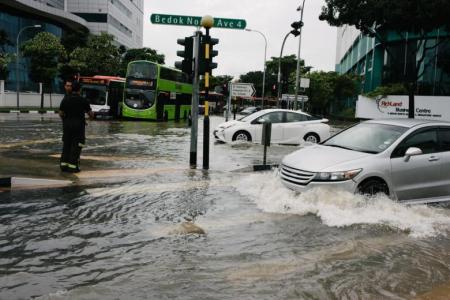What should motorists and residents do in case of a flash flood?
A monsoon surge is expected to bring rainy and cooler weather to Singapore in the final moments of 2021 and the coming New Year weekend.
As at noon on Friday (Dec 31), it was raining across the island, with heavier and thundery showers pelting the northern region. Around 10.55am, national water agency PUB warned in a Twitter post of high flood risk at Commonwealth Lane and Commonwealth Drive as water levels rose above 90 per cent.
The Straits Times looks at what is causing the wet weather, and what to do during a flash flood.
1. What is a monsoon surge, and why does that bring wetter weather?
A monsoon surge is a weather phenomenon that brings cool air and thunderstorms to Singapore.
The country experiences between two and four monsoon surges each year on average, with the events occurring mostly between the months of December and March, during the north-east monsoon season.
The National Environment Agency (NEA) said in a Facebook post on Thursday evening that during the New Year period, occasional spells of thundery showers can be expected, with daily temperatures reaching a low of 23 deg C.
This is the first monsoon surge occurrence in the current north-east monsoon season, added NEA in its post.
Winds blow mainly from the north during the current monsoon season.
During the same season at the start of the year, widespread and continuous showers drenched the country on the first two days of 2021, with Jan 2 receiving one of the highest amounts of rainfall in the past 39 years.
That New Year deluge was also fuelled by a monsoon surge.
2. What should motorists do in the event of a flash flood?
- Avoid driving through flood waters. Water depth of 30cm may stall your car, and 1m-deep waters can carry away most vehicles, including sport utility vehicles.
- If the flood is unavoidable, drive slowly and steadily. Avoid braking to keep engine speed high and consistent. Stay close to the middle of the road, as waters near the kerb tend to be deeper.
- If flood water rises around your car and stalls it, leave your car and move to higher ground, if you are able to do so safely. Call for assistance.
- The PUB quick-response team would be dispatched to the flood location to manage traffic and assist motorists.
3. What should stranded pedestrians do?
- If you see a flooded area ahead, turn back and move to higher ground.
- Watch out for drains, especially open drains that can fill up fast.
- Do not walk through moving water as you could fall in moving waters at least 15cm deep. If you have to walk through water, carefully move where the water is not moving. Do not walk through flood waters higher than your ankles.
4. How should residents and business owners prepare for flash floods?
- Move vehicles to higher ground, and move belongings and shop items to a higher floor. Otherwise, items on the ground can be placed at a higher level using a wooden platform, for instance.
- Set up portable flood barriers and flood panels at entrances. Homes and businesses in flood-prone areas would have received flood barriers and inflatable flood bags, which can soak up flood waters.
- Do not touch electrical equipment if you are wet or standing in water.
- If you must prepare to evacuate, turn off utilities at the main switches or valves, and disconnect electrical appliances.
Get The New Paper on your phone with the free TNP app. Download from the Apple App Store or Google Play Store now



